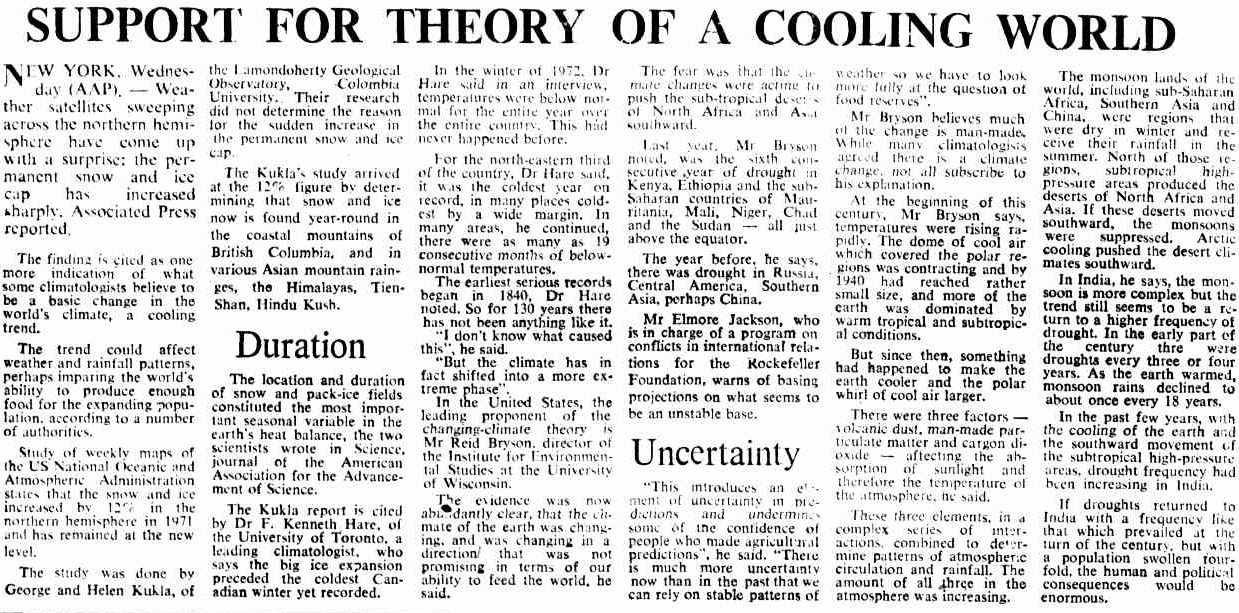Support for a theory of a cooling world
It has some interesting claims in it that sound much like climate change claims made today. Apparently they detected large albedo changes via satellite, with a 12% increase in snow and ice in the Northern Hemisphere that started in 1971, and continued through 1974 when this article was published:
Interactive image here.
They claim that due to albedo changes which help induce cooling, wind, drought, and rainfall patterns will become worse, much like identical claims made today about the effects of warming. The article also claims, quoting Dr. Reid Bryson, there would be increased uncertainty about "stable patterns of weather" that may affect "food reserves", and he also claimed "much of that change was man-made". Sound familiar?
The news article is based on a paper by George J. Kukla, and Helena J. Kukla of the Lamont-Doherty Geological Observatory of Columbia University.
Increased Surface Albedo in the Northern HemisphereBack then, even the BBC was certain enough to bring in Dr. Kukla for an interview to explain how global cooling was a danger for the future.
Did satellites warn of the weather troubles of 1972 and 1973?
Science 22 February 1974: Vol. 183 no. 4126 pp. 709-714 DOI: 10.1126/science.183.4126.709
Routine mapping of snow and ice fields in the northern hemisphere was started by NOAA in 1967. Large year-to-year variations of the snow and pack-ice covers were observed. The annual mean coverage increased by 12 percent during 1971 and has remained high. The index R, which shows the approximate amount of energy reflected from the surface by snow and ice under the mean cloudiness, increased correspondingly. Thus, if the cloud cover over the snow fields did not increase substantially, the anomalous weather patterns of 1972 and 1973 could have been connected with the deficit in surface heat exchange which originated in the northern hemisphere the year before. During the past 7 years the largest changes occurred in the fall and in the continental interiors of Asia and America (8).
Two synoptic parameters which could readily provide information on the development of snow and ice cover in the northern hemisphere are (i) the total area momentarily covered and (ii) the running annual mean of snow and ice coverage for the preceding 1-year period. By 20 September 1973 the annual mean coverage was 37.3 x 106 km2, 11 to 12 percent higher than at the same time during 1968 through 1970. Snow cover-fall, the season when 15 x 106 to 55 x 106 km2 of the northern hemisphere is covered with snow and ice, started on 20 September 1973, compared to 17 September 1972 and 5 or 10 October during 1967 through 1970.
The links between the atmosphere, the oceans, and the land surfaces must be better understood before the role of snow and ice can be thoroughly explained and exploited for long-range weather forecasting. But it is clear that snow, hitherto almost overlooked in synoptic meteorological reports, must be important in the mechanism of weather changes.
And others were still talking about a coming ice age in 1977:
The more things change, the more they stay the same.




According to the Ice Cores of both Antarctica and Greenland, the next Ice Age is due to overdue. The longest lasting was about 20,000 years, the average 10,000 years, and we have burned up 12,000 years. So, you got to ask yourself: "Are we feeling lucky this millennium."